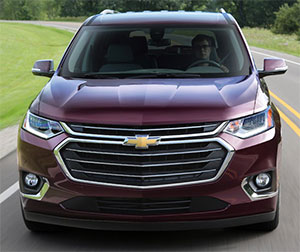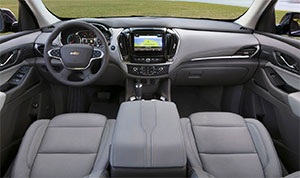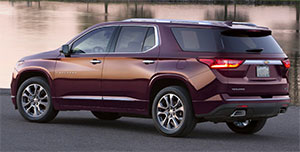2018 Chevrolet Traverse
General Motors pretty much kicked off the large 3-row crossover movement with their 2007 Saturn Outlook. but, it didn’t take long for rivals to one-up the general with slightly smaller and nimbler competition. Since 2009, the Chevrolet Traverse has been the lambda platform’s volume leader. and, while clearly a sales success, it really hasn’t changed much over the years. until now that is. For 2018, what’s old is new again.
Indeed, GM has plenty of experience building 3-row utilities; both in the old school SUV fashion, as well as in today’s more popular crossover style. This 2018 Chevrolet Traverse shares the new global C1XX…or “Chi” platform…with the GMC Acadia and Buick Enclave as before, but thankfully GM continues to increase separation between brands.
On that note, the Traverse is on the long wheelbase version, same as Enclave, while Acadia is on the standard “Chi”.
At 204.3-inches, that gives Traverse about a foot more overall length than its GMC kin. Also, Traverse is the only one of the trio setup for 8-passenger seating.
 Styling is always personal, but sleeker is a word we’ll use. While it’s slightly longer, the new Traverse looks leaner and less bloated, especially on profile, which we think favors the rival Ford Explorer.
Styling is always personal, but sleeker is a word we’ll use. While it’s slightly longer, the new Traverse looks leaner and less bloated, especially on profile, which we think favors the rival Ford Explorer.
Base engine is still a 3.6-liter V6. Now with automatic stop/start, it also adds a tiny bit more displacement thanks to a larger cylinder bore, and ekes out a few more horsepower, at 310. Torque stays the same at 266 lb-ft.
It’s also helped by a new 9-speed automatic transmission.
Believe it or not, a 2.0-liter turbo-4 is the engine upgrade. It features less horsepower, at 255, but more torque at 295 lb-ft. Currently available only in sporty RS trim, and only in front-wheel-drive. All other trims except for the base L, can be equipped with all-wheel-drive; while top level High Country models get a more advanced twin-clutch traction system.
Our time with a front-wheel-drive 3.6-liter, revealed that it remains totally adequate for performing family hauling and commuting duties, but never feels overly powerful. Max. towing is actually down 200-lbs. from last year to an even 5,000.
The 9-speed certainly helps fuel economy, as the Government Ratings are up across the board; now at 18-City, 27-Highway, and 21-Combined. We averaged a good 22.9 miles-per-gallon of Regular.
 For a reasonable, for an SUV, Energy Impact Score of 15.7-barrels of yearly oil use and 6.9 tons of CO2 emissions. 2.0-liter fuel economy ratings are 20-City, 26-Highway, and 22-Combined.
For a reasonable, for an SUV, Energy Impact Score of 15.7-barrels of yearly oil use and 6.9 tons of CO2 emissions. 2.0-liter fuel economy ratings are 20-City, 26-Highway, and 22-Combined.
Better news than all of that, is that the new Traverse fully feels nimbler behind the wheel; on the street at least, which is certainly where the Traverse behaves best. But with that, comes a sense that it’s not quite as solid feeling as some in the segment.
And, on our handling course, we still fought plenty of understeer; steering feel has noticeably improved, but we’d still consider it slow to respond to inputs.
Grunty low-end torque makes for an efficient leap off the line. The quick-revving 6 delivers power stoically throughout the range. We hit 60 more than a second quicker than in our last Traverse test at 6.9-seconds; with the full ¼-mile taking 15.3-seconds at 93 miles-per-hour.
With fade-free, consistent stops from 60 of just 118-feet; we give it very high marks for braking too.
 Don’t know if it’s an early software issue or not; but away from the track, the new 9-speed transmission seemed a little clumsy at times; something we didn’t notice with the more refined driving experience of the new Buick Enclave.
Don’t know if it’s an early software issue or not; but away from the track, the new 9-speed transmission seemed a little clumsy at times; something we didn’t notice with the more refined driving experience of the new Buick Enclave.
“Large and in charge” is the theme inside, with more than adequate room in all seating positions, including the 3rd row…and cargo capacity that’s among class best at 23.0 cubic-ft. behind the 3rd row, 58.1 behind the 2nd, and 98.2 with all seats folded.
Our tester was sensibly equipped in LT trim, which some found a little disappointing. But, High-dollar High Country and RS trims are available if maxing out the bling factor is important to you.
There’s plenty of tech to go around, including GM’s rear camera mirror, 4G LTE Wi-Fi, Apple Car Play and Android Auto, along with lane keep assist and automatic braking.
Traverse pricing is on par with the segment, starting at a reasonable $30,925 and escalating to the very cushy High Country at $53,095.
It’s no secret that GM’s big 3-row crossovers were long overdue for a complete update. And there’s no argument that the 2018 Chevrolet Traverse is now fully improved and modernized. However, we do wonder if GM went far enough. Just being bigger and a bit better doesn’t really cut it in a class where options are many. Still, we do think Chevrolet did enough to be solidly competitive, and the new Traverse will certainly be plenty appealing to all those that prefer their family ride have a domestic name.
Specifications
- Engine: 3.6 liter / 2.0 liter
- Horsepower: 310 / 255
- Torque: 266 lb-ft. / 295 lb-ft.
- 0-60 mph: 6.9 seconds
- 1/4 mile: 15.3 seconds @ 93 mph
- EPA: 18 mpg city / 27 mpg highway
- Energy Impact: 15.7 barrels of oil/yr
- CO2 Emissions: 6.9 tons/yr
2025 Volkswagen ID. Buzz
Volkswagen Brings Beetlemania Level Of Excitement To Minivan Segment
The duty of upholding Volkswagen’s heritage has most recently been delegated to small legacy car names like Golf and Jetta. But hold on! A much larger, totally modern take on VW’s classic microbus has just buzzed over the horizon— the all-electric ID. Buzz. It’s been at the top of our minds since we first saw the concept back in 2017. Well, it’s finally here, so let’s get our groove into drive!
This 2025 Volkswagen ID. Buzz has indeed created the most buzz around Volkswagen since the Beetle’s return to the U.S. in the late 1990s. We couldn’t drive it anywhere without drawing a crowd. No wonder, just about everyone has a VW Microbus story to tell, and seeing this reimagined version rolling down the street brings back all those memories.
VW really pulled it off as far as we’re concerned, as it looks great without appearing over the top. All the cues are here: Big VW logo front and center, lots of greenhouse including A-pillar windows and mini sliders for the second-row passengers, D-pillar air vents, and two-tone wheels. And while its appearance may be pure retro, its drivetrain is far from it, as the ID. Buzz is all-electric, and unlike the new Beetle, the Buzz does retain the original Microbus’ rear-drive architecture.
Powering those rear wheels is a 210-kW motor drawing juice from a 91-kWh battery for a range of 234 miles; 200-kW max charging will get you to 80% in about 26 minutes. Buyers can add another small 80-kW motor up front for 4motion all-wheel-drive and an increase of total output from 282 to 335 horsepower with a combined 512 lb-ft of torque. It uses the same battery, but range estimates drop just slightly to 231 miles. But while those numbers are modest, we also found them to be quite conservative, as we observed as many as 287 miles available in our all-wheel-drive tester’s gauge display and were on pace for 273 miles in our driving loop.
One throwback theme that may be a turnoff to some is that it’s quite a step up into the Buzz’s front seats, but there’s certainly a commanding view of the road once you climb in. Second row seating can be either a three-place bench or a pair of captain’s chairs, so there’s generous room for seven or six passengers. The captain’s chairs in our Pro S Plus offer good support and very easy access to the third row.
Lots of flexibility too with the option to simply fold the seats or remove them altogether.
With the sliding side doors and a wide opening rear hatch, there’s plenty of access for loading big sport utility amounts of cargo. Lots of flexibility too with the option to simply fold the seats or remove them altogether, and the ability to create a full-length flat floor with a rear cargo shelf that covers some handy removable storage bins. There’s 18.6 cubic-feet of space behind the third row, 75.5 behind the second, and a max of 145.5. That’s more than a Chevrolet Tahoe. For smaller items, there are lots of cubbies throughout the cabin, along with a standard Buzz Box that can be moved to multiple locations.
With a design that prioritizes retro form and modern function over aero efficiency, the 4motion equipped ID. Buzz earns a Fair efficiency rating, using 42-kWh of electricity per 100 miles, and we weren’t sure what to expect at our Mason Dixon test track.
What we found was great torque off the line and drama free launches to 60 in just 5.3 seconds. It was very stable at speed and power delivery stayed steady most of the way down the track until we reached about 90 mph, when it began to taper off just before we finished the quarter-mile in 14.0 seconds flat at 97 mph.
With 1,200-lbs. of battery weight nestled in its 127.5-inch wheelbase, the Buzz felt planted to the pavement through our handling course. There was quite a bit of body roll to deal with, but surprisingly little understeer. In panic braking runs, pedal response was inconsistent, feeling soft at times, pushing back hard at others; but through it all, results were quite good, stopping from 60 in an average of just 108 feet.
Three interior themes are available, this Dune is the brightest, featuring coastal inspired wood optic dash décor, “gray and clay” leatherette surfaces, and a high-mounted central 12.9-inch touchscreen. Pricing starts with a rear-wheel-drive Pro S at $61,545; this Pro S Plus begins at $65,045, add another $4,500 for 4motion, which brings a few extra features along with all-wheel drive.
Retro design with old-school VW charm, modern EV drivetrain, big SUV capacity merged with minivan flexibility; it all comes together in this 2025 Volkswagen ID. Buzz. It’s easily one of the coolest rides of the year and one that will likely keep Volkswagen dealers buzzing for years to come, and that’s something no other people and things mover can say.
Specifications
As Tested
- Motor Setup: Dual-Motor AWD
- Battery Size: 91-kWh
- Horsepower: 335
- Torque: 512 lb-ft
- EPA Range: 231 miles
- 0-60 mph: 5.3 seconds
- 1/4 Mile: 14.0 seconds at 97 mph
- Braking, 60-0: 108 feet
- MW Test Loop: ~ 273 miles













































